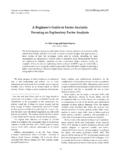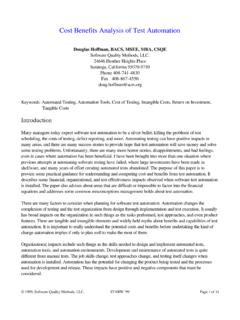Transcription of First in Human Studies - ABPI
1 First in Human Studies : Points to Consider in Study Placement, Design and ConductJanuary 2011 AcknowledgementsThe primary authors were: Pauline Williams, DamianO'Connell, and Odile article was produced under the auspices of theABPI Experimental Medicine Expert Network. The authors based the article on FIH guidelines thathad been produced within GSK and Pfizer. The authors thank David Sciberras, Cyril Clarke,Corinne Cummings, Jo Collier, Juliet McColm, GerryParker and Oliver Schmidt from the Network forreview, and Jan de Hoon for external in Human (FIH) clinical trials are part of theexploratory phase of drug development and represent asignificant milestone in the clinical development of newmedicines. When only preclinical data are available toguide dose-selection, population, study design, safetymonitoring and appropriate expertise are all critical tomaximise the safety of the study subjects and thequality of the has been intense focus on the risks of FIHclinical trials since the TeGenero TGN1412 incident in2006, and much has been published on the evidenceand recommendations [1, 2, 3, 4].
2 The European MedicinesAgency s (EMA) Guideline on strategies to identifyand mitigate risks for First in Human clinical trials withInvestigational Medicinal Products (IMPs) [5]providesan excellent overview of points to consider. Inaddition, the ABPI Guidelines for Phase I ClinicalTrials [6]summarise recognised industry standards. Thepurpose of this document is to supplement theseguidelines with practical considerations for theplanning, design and conduct of FIH clinical include sections on: Choice of study population Selection of an appropriate study site and principal investigator Formulation and site pharmacy considerations Study design considerations Dose escalation decisions Informed consent considerationsChoice of study populationThe majority of FIH clinical trials use healthyvolunteers. This approach has the advantage of speedof recruitment and ease of scheduling cohorts ofsubjects throughout the study. It also removes potentialconfounding factors such as concomitant medicationand disease pathology when reviewing adverse eventand pharmacokinetic (PK) data.
3 Healthy volunteers cangenerally tolerate more intensive interventions andadverse effects than would be expected from asymptomatic patient. FIH clinical trials are part of the exploratory phase ofdrug development and therapeutic benefit is not anobjective. Clearly healthy individuals do not stand togain any therapeutic benefit from an investigationaldrug, and ethical principles dictate that they should notbe exposed to any more than minimal risk [7]. Inpatients, the foreseeable risks should also be kept aslow as possible. Historically, the use of patients hasbeen commonplace for oncology agents and agentswith low therapeutic index intended for life-threatening decision whether to conduct an FIH trial inhealthy volunteers or patients should be carefullyconsidered and fully justified on a case-by-case pros and cons are detailed in Table 1. The safetyof subjects and the value of the information that islikely to be obtained should be considered, especially:a) the risks inherent in the type of medicinal productand its molecular target b) potential immediate and long term toxicitypredicted from non-clinical or literature information c) the presence of the target, key biomarker or asurrogate marker in healthy subjects or in patientsonly, and d) the possibility and impact of higher variability inpatients versus lower external validity in in Human Studies Points to Consider in Study Placement, Design and ConductJanuary 20111 Table 1.
4 Selection of Patients versus study designs may include bridging betweenhealthy volunteers and a patient population once theexpected therapeutically relevant dose is achieved inthe escalation paradigm. This allows a more time- andcost-efficient early evaluation of PK, PD and safetyparameters at lower doses in healthy subjects tofacilitate improved dose-selection and/or regime athigher doses in the target patient population, in whommore informative safety or PD data can be of women as early as possible in drugdevelopment programmes is encouraged. The ICH M3 Revision 2 (R2) guideline [8]describes the nonclinicalstudy guidelines for enrolling women of child-bearingpotential into clinical Studies . In the FIH clinical trial,women will typically be of non-child bearing addition, a risk evaluation should be conducted toestablish the need for protection from seminal IMPexposure, or the need to add a highly effective methodto avoid pregnancy for the women of child-bearingpotential who are partners of male subjects in the FIHclinical trial.
5 Highly effective methods to avoidpregnancy are defined in the ICH guideline [8]as those,alone or in combination, that result in a low failure rate( , less than 1% per year) when used consistently is important to confirm the medical history of thevolunteers or patients prior to inclusion in a FIHclinical trial, which is usually done by contacting theprimary care physician. Choice of research siteThe sponsor should conduct a site evaluation toconsider the site s capabilities to meet the specificdemands of a particular protocol such as appropriatemedical governance, drug-specific biomarkermethodologies or sample acquisition/analysis, theability to recruit study participants, and pharmacycapabilities. FIH clinical trials of IMPs with identified factors of risk(as discussed in [Appendix 1]) should be conducted inresearch units with sufficient expertise and know-howand which, in the UK, have been awarded the MHRAP hase 1 Supplementary Accreditation [9]as they willhave undergone a comprehensive scrutiny of theiremergency equipment, procedures and , this does not negate the importance of a site-evaluation by sponsor staff.
6 Furthermore, the MHRAP hase 1 Accreditation is voluntary, there is nomandatory requirement for it. Site assessment by thesponsor staff should include, but not be limited to,evaluation of the experience of the site with FIHclinical trials and the ability to carry out appropriatesafety monitoring, the site s experience with IMPs of alllevels of risk, the site s process and experience withdose escalation decisions, the site s facilities and abilityfor stabilising individuals in an acute emergency andthe site s ability to conduct resuscitation, the proximityto hospital and the access to Intensive Care Services,and ready availability of Intensive Care Unit facilities. HEALTHY VOLUNTEERSPATIENTSPROs Easier recruitment andmanagement in the clinical unit Recruitment quicker, resultingin more efficient study No confounding pathology ormedications Easier to obtain blood for fullPK profile Data may be useful for severalindications Wide choice of potential FIHsites and investigators High internal validity Pharmacodynamic(PD)/biomarker and surrogatedata may only be obtainable inpatients Target-related safety may betested Possible benefit, especially athigher doses High external validityCONs Often no or limited target-related PD/biomarker dataobtainable Often difficult to justify targetavailability in healthy volunteers(but may be expressed at lowlevels) Target-related safety may bedifferent from patients (but off-target toxicity likely to besimilar)
7 PK may be different frompatients No therapeutic benefit tosubjects, only potential risks Low external validity Recruitment and managementoften more difficult, resulting inless efficient study ( timelines and highercosts) Sites that have the patients mayhave no experience in FIHclinical trials or facilities forextended in-house monitoring Concomitant disorders andmedications confoundinterpretation of safety data Greater variability in safetysignals Target-related safety may stillbe different in other indications Single dose, or low doses, maynot provide adequatetherapeutic benefit to justifyentering very ill patients intothe study, and may precludeparticipation in subsequenttrials Potentially more difficult toobtain blood for PK (considersparse sampling for populationPK) Ethical concerns aroundplacebo use2In FIH clinical trials where there is a predictable risk ofcertain types of severe adverse reaction, the sponsorshould specifically address risk mitigation in theprotocol, which should include considerations fortreatment of such reactions.
8 The sponsor and researchsite should ensure the specific antidotes will be readilyavailable, where they exist, as well as a clear plan ofsupportive treatment, including the pre-arrangedcontingency availability of intensive care facilities orspecialty consultation. The research site should assessthe study-specific requirements for clinical cover andensure that an appropriate level of staffing, withmedical doctors during and after dosing, will IMPs other than those with identified factors ofrisk, the sponsor should consider similar factors thanpreviously discussed, on a case by case basis. As aminimum, the sponsor must assess facilities, trainingand experience of personnel, and the evidence that unitmedical staff are appropriately qualified and trained inhandling emergency situations. The principal investigator and unit staff responsible forthe care of subjects in FIH clinical trials should alwaysbe appropriately qualified and experienced. In the UK,the principal investigator will hold a post-graduatequalification related to pharmacology, such as theDiploma of Human Pharmacology [10], or equivalent, asdescribed in the MHRA Phase 1 Accreditation scheme[9].
9 The sponsor should ensure that the investigatorknows enough about the agent, its target, mechanism ofaction and potential adverse events to be in a positionto manage the informed consent process with thesubject, and to make informed clinical judgmentsduring the study. The investigator must also understandthe intricacies of executing FIH clinical trials, includingthe potential need to adjust doses during the study ashuman data become available. The sponsor should give consideration to the pharmacylicence, which is discussed in the section , it is critical that subjects taking part in FIHclinical trials have not been recently exposed to otherinvestigational products. Therefore sites using web-based systems to monitor for over-volunteering , [11]or NVR [12], provide a valuable safeguard againstthe professional volunteer .Formulation and site pharmacyWhen designing an FIH clinical trial, the sponsordevelopment team must consider the formulation thatwill be used and the need for flexibility to permitadjustment of doses in real-time as safety and PK databecome available.
10 Unless an open-label study isplanned, matching placebo will also be required forblinding formulations used in FIH clinical trials havegenerally not yet been optimised, and the sponsorshould therefore identify as soon as possible whetherthe dosage form will require specific preparation at theresearch site (for example, dilution for preparation ofan intravenous infusion, or preparation of asuspension). The sponsor should pay great attention tothe type of licence held by the research site s pharmacyto ensure the study is placed at a site that can performthe preparation. The research site should have anequipped investigational drug pharmacy, staffed withqualified pharmacist/s and/or technician/s who haveexperience preparing special dosage forms typicallyused in FIH evaluations ( oral powder forconstitution, intravenous formulations requiringdilution steps, etc). The sponsor should ensure that thesite pharmacy holds the appropriate manufacturing andassembly licence, such as the MIA (IMP) licenceawarded by the MHRA, and that this licence isreferenced in the IMPD submission to the MHRA, forall sites based in the UK.





